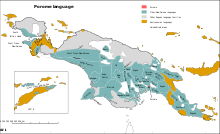Porome language
| Porome | |
|---|---|
| Kibiri | |
| Native to | Papua New Guinea |
| Region | Gulf Province, Kikori District, near Aird Hills, on several tributaries of Kikori River, villages of Tipeowo, Doibo, Paile, Babaguina, Ero, and Wowa.southern Papua New Guinea |
| Coordinates | 7°27′S 144°17′E / 7.450°S 144.283°E |
Native speakers | 1,200 (2011)[1] |
| Dialects |
|
| Language codes | |
| ISO 639-3 |
prm |
| Glottolog |
kibi1239[2] |
 Map: The Porome language of New Guinea
The Porome language (large bay, southern PNG)
Trans–New Guinea languages
Other Papuan languages
Austronesian languages
Uninhabited | |
Porome, also known as Kibiri, is a Papuan language of southern Papua New Guinea. There are over a thousand speakers.
Porome was classified as a language isolate by Stephen Wurm. Although Malcolm Ross linked it to the Kiwaian languages, there is no evidence for a connection apart from the pronouns 1sg amo and 2sg do.
The independent pronouns and subject suffixes to the verb are as follows:
sg du pl 1 amo, -me amó-kai amó, -ke/-ki 2 do, -ke aia-kai a, -ka 3 da, -a/-bV abo-kai abo, -abo
References
- ↑ Porome at Ethnologue (18th ed., 2015)
- ↑ Hammarström, Harald; Forkel, Robert; Haspelmath, Martin, eds. (2017). "Kibiri". Glottolog 3.0. Jena, Germany: Max Planck Institute for the Science of Human History.
- Ross, Malcolm (2005). "Pronouns as a preliminary diagnostic for grouping Papuan languages". In Andrew Pawley; Robert Attenborough; Robin Hide; Jack Golson. Papuan pasts: cultural, linguistic and biological histories of Papuan-speaking peoples. Canberra: Pacific Linguistics. pp. 15&ndash, 66. ISBN 0858835622. OCLC 67292782.
This article is issued from
Wikipedia.
The text is licensed under Creative Commons - Attribution - Sharealike.
Additional terms may apply for the media files.